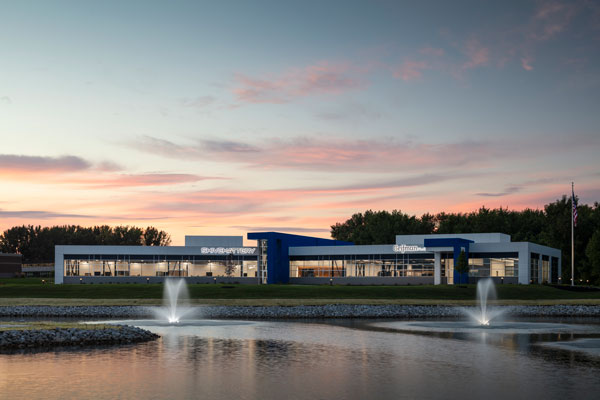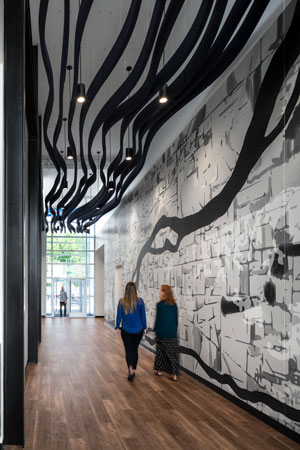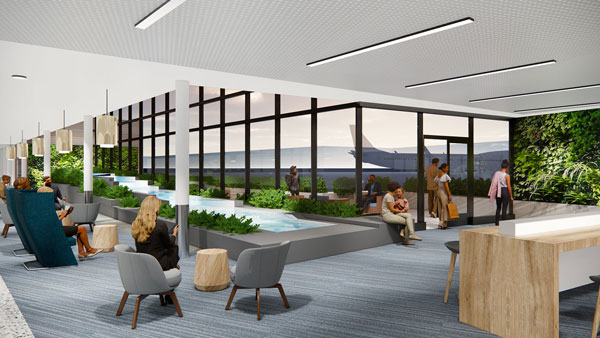In management or editorial speak, “QC” stands for quality control, that endless process of getting things right as close to 100% of the time as possible. In the center of the United States, QC stands for “Quad Cities,” known for a manufacturing heritage that likes to do things right the first time.
Forty years ago I matriculated at a wonderful liberal arts school in the Midwest called Knox College, in Galesburg, Illinois, long known as a major rail hub and manufacturing center, even if it had seen better days. The Quad Cities, less than an hour north of Galesburg, were a place I barely registered back then but a place more people and companies are registering now: The region is the land of John Deere and the birthplace of the Rock Island Line that first connected to Chicago 170 years ago in 1854. And the area’s better days are happening as we speak.
Five cities — not four — comprise the core of the Quad Cities: Bettendorf and Davenport, Iowa, and East Moline, Moline and Rock Island, Illinois. But the QC region is an entire family of communities in Clinton, Muscatine and Scott Counties in Iowa and Henry, Mercer and Rock Island Counties in Illinois. Places with names like Clinton, Eldridge and Pleasant Valley in Iowa, and Milan, Rapids City, Silvis (host to the PGA Tour’s John Deere Classic) and Oak Grove in Illinois.
As recently as 2022, manufacturing represented $6 billion of the $31 billion GDP in a region that gained nearly 9,000 jobs that year. Home to nearly 475,000 residents, the area boast a median per capita income of $66,512 in a part of the country where a lot of people (and their employers) are discovering how far a dollar can go.
In 2023, companies invested $393.4 million of those dollars, creating 457 new jobs, many in the Quad Cities Chamber’s five target industries:
- advanced metals & materials manufacturing
- agricultural innovation — agricultural equipment manufacturing & food production
- logistics
- corporate operations & support services
- defense
A recent Quad Cities Chamber testimonial puts things in a nutshell: “The Quad Cities has career opportunities that are very lucrative and a low cost of living,” said Valentin Ezugha, director of site maintenance at Exelon Nuclear. “So, your income goes a long way, which really allows you to advance your family.”


Iowa-based national architecture and engineering firm Shive-Hattery recently opened this new office in Bettendorf.
Photos by AJ Brown Imaging courtesy of Shive-Hattery
Advancing goods where they need to go is literally central to the area’s value proposition, positioned as it is within 300 highway miles of Chicago, Indianapolis, Des Moines, Kansas City, Omaha, St. Louis and Milwaukee. Five freight railroads serve the area, as does the world’s largest truck stop on busy I-80 in Walcott, Iowa: As it happens, Iowa 80 Truckstop, which every year hosts the Walcott Truckers Jamboree, this year is celebrating its 60th anniversary with its own facility expansion: a 251,000-sq.-ft. e-commerce distribution center that opened in February to ship out truck parts, accessories and much more, with half the space available for rent.
As more global companies every day diversify their location portfolios to places where they get more bang for their buck, QC and the global companies already there are happy to welcome them to a place that’s not such a secret anymore. Three recent conversations shed light on why this region is positioned to sustain the momentum.
‘A Place Here for Everyone’
Before she became president of nationally prominent architecture and engineering firm Shive-Hattery, based in Cedar Rapids, Jennifer Bennett served as vice president and office director of the company’s Quad Cities location. The company recently invested in a gleaming new office in the area in Bettendorf after a truly region-wide site selection process.
“We looked at dozens of locations including Bettendorf and Davenport in Iowa and Moline, East Moline and Rock Island on the Illinois side,” she tells me. “In the end, the Bettendorf site won out. It’s a beautiful site. The location is easily accessible for our clients and our employees who live throughout the Quad Cities. Most of our employee commutes are under 15 minutes regardless of where they live in the QC. We also enjoy being collocated on site with the site developer Geifman First Equity, a long-time trusted partner on many projects.”
 Building on a regional reputation for transportation connectivity, Quad Cities International Airport in April broke ground on the first project in its Project GATEWAY expansion and modernization plan. New daily flights to Charlotte helped boost QCIA’s February 2024 passenger count by 20% over the previous February.
Building on a regional reputation for transportation connectivity, Quad Cities International Airport in April broke ground on the first project in its Project GATEWAY expansion and modernization plan. New daily flights to Charlotte helped boost QCIA’s February 2024 passenger count by 20% over the previous February.
Rendering courtesy of QCIA
It’s natural to wonder how a bi-state area’s economic development strategy works out when one state’s policies differ from its neighbor’s. Asked to characterize the level of regionalism in the area today vs. when she first started working there, Bennett says, “Over my career, I’ve enjoyed being a part of the evolution of the Quad Cities from somewhat siloed individual cities to a true region. Today, the Quad Cities is a region that works together for economic development, placemaking, and attraction and retention of workforce. Each city in the Quad Cities has its own ‘personality’ and these personalities are embraced as part of the diversity of the region. Many of the challenges and opportunities faced by the individual cities are overcome with a collaborative approach that involves an active business community working together with the municipalities. It truly is a special place.”
As for the state dynamics, “Most businesses in the Quad Cities have employees who live on both sides of the river, so navigating the different employment laws in both states just comes with the territory,” she says.” The region, through its organizations like the Quad Cities Chamber, is good at identifying changes in employment law in one state or the other and offering seminars on how to best navigate the change. This was especially helpful during Covid.” Likewise, depending on business needs, one community or state may be more advantageous for a given project when it comes to tax considerations, permitting requirements and incentives, she says. “We really enjoy working with our clients and their site selectors to find the right site for them considering all aspects of the site, including the day-to-day operating environment. There is a place here for everyone.”
The Site Consultant’s Viewpoint

Barry Matherly,
President and CEO,
Hickey Global
Barry Matherly, president and CEO of Hickey Global, is leading the effort to develop a regional site readiness strategy and economic development implementation plan for the Quad Cities Chamber. After an initial visit to the area with David Hickey, managing director of Hickey & Associates, he professed admiration for the region’s success with speculative development and shell buildings. When I spoke with him in the spring, his enthusiasm had not faltered.
“One thing we love about the region is its commitment to manufacturing has been unwavering,” he says. “As the U.S. de-prioritized manufacturing, we’re spending billions of dollars and a lot of time trying to get back what we lost for decades. Here is a region that understood and built training programs.”
Among the programs:
- Black Hawk College’s Ignite program for advanced manufacturing was founded in 2022 with the partnership of Deere & Co. and the Safer Foundation, with partial funding from the Department of Defense.
- The successful Quad Cities High School Apprenticeship Program last year saw 72 apprentices, fully outfitted in John Deere caps and t-shirts, sign agreements to apprentice at 16 different companies in the area across eight different sectors. The program backed by the Quad Cities Chamber also saw additional support in the form of new legislation last year, as Gov. Kim Reynolds attended the program’s ceremony in Bettendorf to sign the Iowa Registered Apprenticeship Act into law, officially establishing the Iowa Office of Apprenticeship with Iowa Workforce Development.
- Fitting in nicely with the QC region’s Rock Island Arsenal and military affinity, Iowa has been approved as a third-party approver for the Department of Defense’s Skillbridge program, which works with businesses to open more opportunities for transitioning service men and women.
- In an offering unique to the area, Baltimore-based Christian humanitarian organization World Relief in September 2023 launched refugee resettlement programs in multiple new locations nationally that include Scott County, Iowa, and Rock Island County, Illinois. The organization offers immigration legal services, employment services, mental health services and English education classes.
From a site readiness perspective, Matherly says his team is putting together an overall strategy based on site-by-site analysis. “In general, there are a lot of good medium-sized to large sites that are really well developed,” he says, noting that it’s easy for those in other parts of the country to “forget how flat it is in that part of the country, and mostly clear. There is a lot of good infrastructure built right into those sites.”
 Deere & Co.’s global headquarters in the Quad Cities is a corporate anchor, workforce development engine and economic development driver all at once.
Deere & Co.’s global headquarters in the Quad Cities is a corporate anchor, workforce development engine and economic development driver all at once.
Photo courtesy of Deere & Co.
There is good balance and variety too, he says, with more sheer product on the Iowa side right now, but unique aspects on the Illinois side, especially for dual Interstate highway or heavy rail requirements. Throw in the mix of regulated and deregulated utilities between the two states and tools such as tax-increment financing for infrastructure and there are a lot of possibilities already coming to fruition, he says, including that robust spec building trend that Matherly, as a former economic developer, knows is hard to come by and therefore characterizes as “amazing.”
“Not only is there product up right now and under construction, but from our visit we found there are a lot of developers buying up land for future spec building. They already have infrastructure or close proximity to it to get more spec buildings out of the ground. Not many communities can pull that off. It’s the ultimate faith to see developers willing to put tens of millions of dollars at risk.”
Matherly reiterates Jennifer Bennett’s observation about a real sense of regionalism across the two states. “It is definitely a regional vibe. People move effortlessly back and forth,” he says. “It’s not a situation where a group from one side goes to work on the other side and comes back out. People are working and living on both sides, and in almost any group we talked about, there was a distribution between the two states,” symbolized, he says, by the new I-74 Iowa-Illinois Memorial Bridge completed last year across the Mississippi. “It’s a very easy, beautiful, symbolic way to move back and forth through the region.”
Matherly sees the site development strategy also balancing out nicely with the area’s quality-of-life evolution along its redeveloping waterfront, where he learned about something he didn’t know about before: TugFest.
“TugFest is the only tug of war across the Mississippi River,” he says of the annual tug of war contest between LeClaire, Iowa, and Port Byron, Illinois. “That says something about the river in general and the community bond.” It’s not the only waterfront event. 2024 marks the 50th running of the challenging Quad-City Times Bix 7 seven-mile run. Last year that event coincided with the final stage of the famous RAGBRAI bike ride across Iowa.
Matherly says the redevelopment work ties into the industrial work because many of those downtown sites are old industrial sites. “There is a great tie-in between that manufacturing heritage and the future sites they’re building in these modern spec buildings,” he says, “redeveloping older heritage into something like a lifestyle asset. It’s something executives in the area are very supportive of. The river’s not new to them. And it’s not just a river. It’s the Mississippi River.”
Atlas Knows the Lay of the Land
In the Mississippi River Corridor rankings published in the March 2024 issue of Site Selection, Clinton, Iowa, in the northern reaches of the Quad Cities region, was ranked No. 4 in total corporate facility investment projects per capita over an 18-month period. Those projects included a $308 million investment by Archer Daniels Midland (ADM) in a new corn wetmill, an $18 million investment from Merrill Steel in the former TMK IPSCO plant located in Camanche, Iowa, and the construction of a $224 million asphalt shingle manufacturing plant by Atlas Roofing Corporation in the Lincolnway Industrial Rail & Air Park that will create 117 new jobs.
The Quad Cities Chamber hosted Atlas’ first site visit to the region in June of 2019 and supported Grow Clinton in the final attraction in 2023. A major supplier figured into the process too: Davenport-based Linwood Mining will be Atlas’ aggregate supplier of high calcium limestone for use in their manufacturing of roofing shingles, the Chamber said. “Linwood’s presence in the Quad Cities was a key factor in initially attracting and eventually bringing Atlas to the region,” said a Chamber release.

The new Iowa-Illinois Memorial Bridge not only has pedestrian and cycling pathways but symbolizes the ease with which residents move back and forth across the Mississippi in a true bi-state region.
Photo courtesy of Quad Cities Chamber
“The arrival of Atlas proves that Clinton, Iowa, has the workforce and pro-business environment to attract a company of high caliber,” said Matt Brooke, city administrator. “The Lincolnway Industrial Rail & Air Park is now a plug-and-play site, with a brand new road, expanded public rail, and the complete build-out of all utilities. It was great working with Grow Clinton, the City of Low Moor, Iowa DOT, Iowa Economic Development Authority and several land owners to see this project come to fruition.”
From a single asphalt shingle manufacturing facility in 1982, Atlas has grown to 36 facilities in North America. The company already operates a molded products manufacturing facility in Washington, Iowa, just south of Iowa City and a roof and wall insulation facility in the Quad Cities community of East Moline, Illinois. The Clinton shingles and underlayments operation completes a regional trifecta that’s only repeated across the company’s 36-facility North American portfolio in one other region: its home region of Greater Atlanta. So it’s fair to say the QC feels like home to Atlas.
Andy Sokolovich, president and CEO of Grow Clinton, calls the Atlas investment “a dream project” that came to his team exactly one year before the final announcement. “I remember getting a call in August two years ago that there was a prospect who wanted to visit the site. It was the same day as the Grow Clinton golf outing. But I said, ‘Priorities,’ so I went out there in shorts and a polo shirt, put boots on the ground and met with three individuals from Atlas.”
A rail bridge weight restriction that would prevent loading full railcars at a competing site in the region helped steer Atlas to Clinton, Sokolovich says. “Up at our site there are no weight restrictions whatsoever.” He gives full credit to Alliant Energy too, as the utility purchased 210 acres adjacent to the original 70-acre industrial park site in order to allow Atlas the access and egress it needed.
The project is also a test of regionalism in a community where things weren’t always that way. Sokolovich says previous leaders in Clinton wanted to go it alone and didn’t fully understand the dynamic of working with the Quad Cities. “I knew their capabilities and assets. It seemed crazy not to leverage those with our staff. When the Quad Cities Chamber brings us a lead, we often invite their staff to come up and we share info about regional employers. Often something pops up where I don’t have the answer but the Chamber does. A prospective company couldn’t care less who sits in that seat as long as they get a response.”
In the case of Atlas, both organizations were in the same seat, it turned out. “They were working on the project through a different code name, and we quickly realized we were working the same project,” Sokolovich says, noting that Jenelle Wolber, the Chamber’s director of business & economic growth services, used to work with the team in Clinton and “knows where the squirrels buried the nuts” at the Lincolnway park she helped get certified. “When Grow Clinton revealed it was Atlas, they were nothing but happy for us and offered to help in any way they possibly could,” Sokolovich says.
Which is fitting, after all, for a region that likes to do things right the first time.

